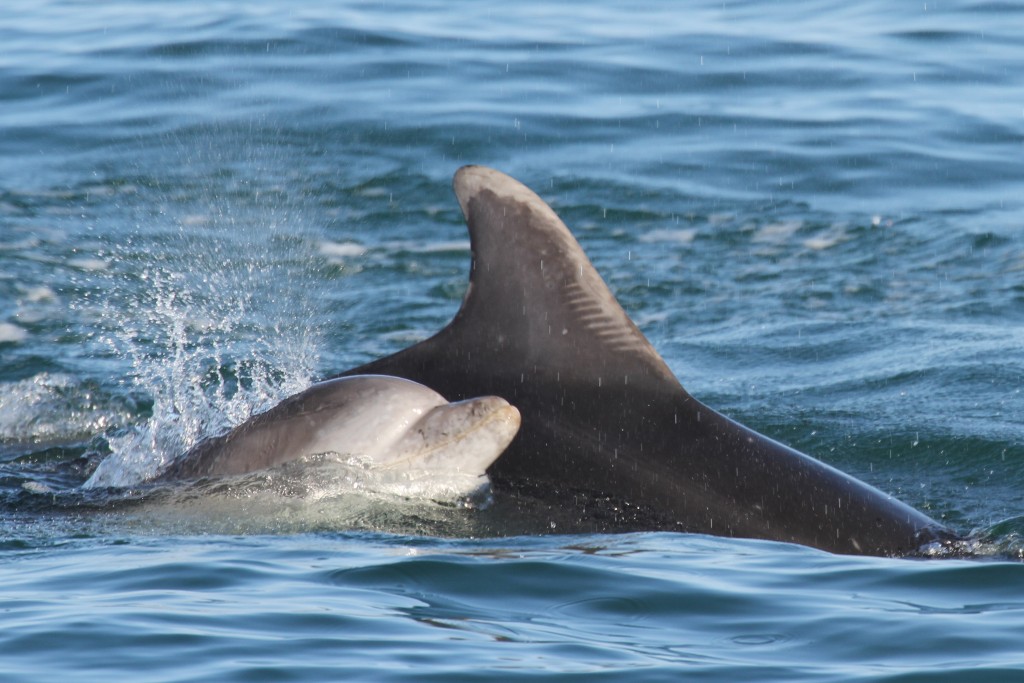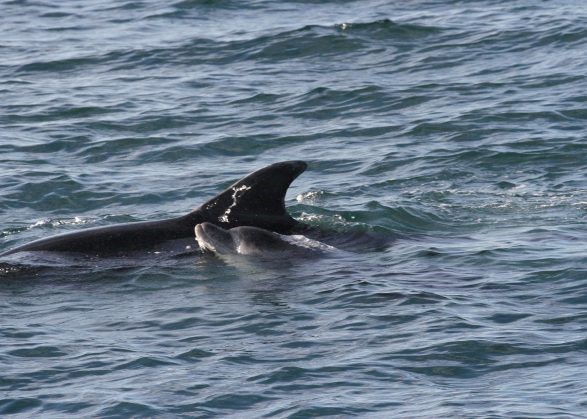When Can Female Dolphin Get Pregnant Again
Research has shown that pregnancy in Bottlenose dolphins lasts twelve months and while in that location is no set dominion in terms of seasonality, the splash of young fins in the United kingdom unremarkably occurs during the summer months, most ofttimes between March and September.
There is very petty room in the uterus for a baby dolphin to develop. Every bit a result, and to brand birth easier, the tail fluke and dorsal fin are cartilaginous and are folded over in the uterus. When they are built-in both the tail fluke and the dorsal fin will be floppy just will gradually stiffen over fourth dimension. The young dolphin will accept foetal folds which expect similar long stripes running down their trunk when information technology is outset born but these volition fade over time.

When the new dogie finally emerges he or she volition exist 1 metre long and be birthed tail first. During the commitment, some other female dolphin will act like a midwife to help ensure that the new-built-in reaches the surface to accept its first breath. If the calving process has exhausted her the 'dolphin midwife' volition also assistance the mother attain the surface so she can breathe too . Equally far as we know today, the birth of a dolphin in the wild has never been observed. All we know about the dolphin birthing process has been learned by our observation of captive animals.
The new calf volition suckle for around eighteen-xx months and every bit a outcome the mother typically wont brood again for 2-iii years and in some cases the female hasn't had another dogie for up to 6 years later. If the calf is male he won't be sexually mature until he is betwixt the ages of 8 and 15 while females achieve sexually maturity between 5 and 13 years. When it comes to mothering manner, dolphins are much similar humans in that each female person dolphin seems to have a unique mothering manner. Some mothers are very protective parents, while others seem more relaxed with letting their calves explore and others fall somewhere in-between.
The cow (new dolphin female parent), experiences significant changes post-partum (following nascence). Ane of the most significant changes seen is the amount and blueprint of sleep she exhibits afterward the birthing process. Studies by UCLA have been performed to evaluate sleep patterns of the dolphin neonate and its new female parent. Data collected suggests that new dolphin mothers get little to no sleep for at least the first two months mail service-partum. This is due to the vigilance needed to care for and protect the new-born. The new-born, on the other hand, sleeps extensively during this time. Something I am sure many new parents can relate to.
Another similarity between dolphins and us is that they name their offspring. These names are created through a serial of clicks and whistles. Researchers have recorded dolphins repeating the new-born calf's names over and over just after nativity. This is believed to help the new dogie learn their ain name. As humans, we are unable to completely understand the complex language of dolphins then when individuals are identified nosotros requite them names. Recently at Body of water Watch, Katrin spotted Berry, one of our resident dolphins with a new dogie. This is our start known calf of the season and we are looking for help to name him/her.
Until the 30th May, you lot the public take the chance to enter our naming competition for £ane. If you lot are interested in getting involved and then speak to one of our volunteers at the pier or click here to enter online via our website. All the money collected will become towards ensuring the connected research and monitoring of the Cardigan Bay Dolphins.

Written by Laura Watson, Research Intern 2017.
Source: https://www.seawatchfoundation.org.uk/pregnancy-and-birthing-in-bottlenose-dolphins/